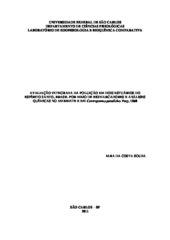Avaliação integrada da poluição em dois estuários do Espírito Santo, Brasil por meio de biomarcadores e análises químicas no ambiente e em Centropomus parallelus Poey, 1860
Abstract
Estuarine and coastal regions are often impacted by various anthropogenic influences derived from industries, port activities, agriculture and sewage. Two Brazilian estuaries (Piraque-açu - ES and Santa Maria - ES) were evaluated in order to correlate genetic, biochemical, morphological and physiological biomarkers determined in the fish Centropomus parallelus with water quality parameters, metals in superficial and interstitial water and sediments. Integrated physical and chemical parameters were measured in Victoria Bay and Santa Cruz during the winter and summer. Al, Cr, Mn, Fe, Ni, Cu, Zn, Se, Ag, Cd, Pb, Hg were observed in samples of water, interstitial water, sediment and fish muscle. Biomarkers include the frequency of micronuclei and nuclear alterations, NKA activity, histopathological changes and cellular chloride. The biomarkers showed changes mostly at reversible, triggering mild to moderate level of contamination. The characteristics of the estuary, as organic matter and dissolved oxygen are correlated with the concentration of metals present in C. parallelus, influencing the bioavailability of the same. The combined use of biomarkers to measures of water quality shows the importance of assessing the degree of contamination and its consequences for aquatic biota.
